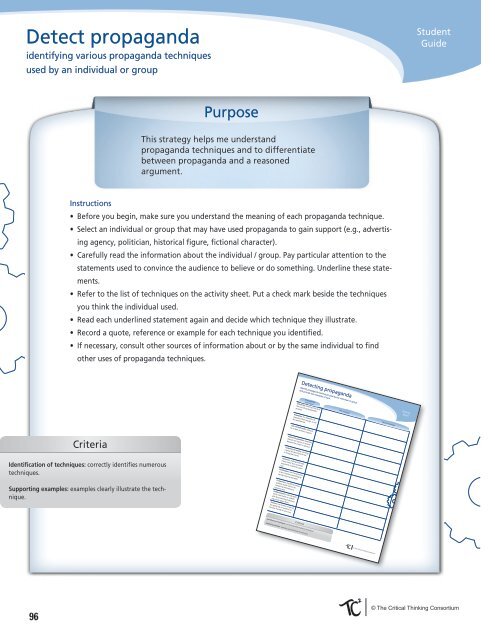Residential Residential
Residential_School
Residential_School
Create successful ePaper yourself
Turn your PDF publications into a flip-book with our unique Google optimized e-Paper software.
Propaganda<br />
techniques<br />
Second example<br />
Detect propaganda<br />
identifying various propaganda techniques<br />
used by an individual or group<br />
Student<br />
Guide<br />
Purpose<br />
This strategy helps me understand<br />
propaganda techniques and to differentiate<br />
between propaganda and a reasoned<br />
argument.<br />
Instructions<br />
• Before you begin, make sure you understand the meaning of each propaganda technique.<br />
• Select an individual or group that may have used propaganda to gain support (e.g., advertising<br />
agency, politician, historical figure, fictional character).<br />
• Carefully read the information about the individual / group. Pay particular attention to the<br />
statements used to convince the audience to believe or do something. Underline these statements.<br />
• Refer to the list of techniques on the activity sheet. Put a check mark beside the techniques<br />
you think the individual used.<br />
• Read each underlined statement again and decide which technique they illustrate.<br />
• Record a quote, reference or example for each technique you identified.<br />
• If necessary, consult other sources of information about or by the same individual to find<br />
other uses of propaganda techniques.<br />
Identify propaganda techniques used by the individual or group<br />
Detecting propaganda<br />
and provide two examples of each.<br />
Selectivity: selecting only facts<br />
that suit the propagandists’<br />
purpose<br />
First example<br />
Activity<br />
Repetition: if a statement is<br />
Sheet<br />
repeated often enough, it will<br />
be remembered<br />
Lies and half-truths: telling a<br />
lie to gain audience support<br />
Criteria<br />
Rhetorical questions: questions<br />
that do not require an answer<br />
because the answer is obvious<br />
Targeting the enemy: unifying<br />
a group by identifying a real<br />
or imagined enemy<br />
Identification of techniques: correctly identifies numerous<br />
techniques.<br />
Assertion: making bold statements<br />
rather than reasoned<br />
arguments to defend a position<br />
Bandwagon: convincing others<br />
to do or believe something by<br />
saying everyone else does<br />
Supporting examples: examples clearly illustrate the technique.<br />
Comparison: amplifying values,<br />
qualities and/or actions by<br />
comparing themselves to<br />
someone else<br />
Embarrassment: making opponents<br />
look foolish or undesirable<br />
by presenting embarrassing<br />
stories about them<br />
Humour: use humour to get on<br />
the good side of audience or<br />
become friendly to win trust<br />
Identification of techniques: correctly identifies numerous techniques.<br />
Criteria<br />
Supporting examples: examples clearly illustrate the technique.<br />
© The Critical Thinking Consortium<br />
96<br />
© The Critical Thinking Consortium


